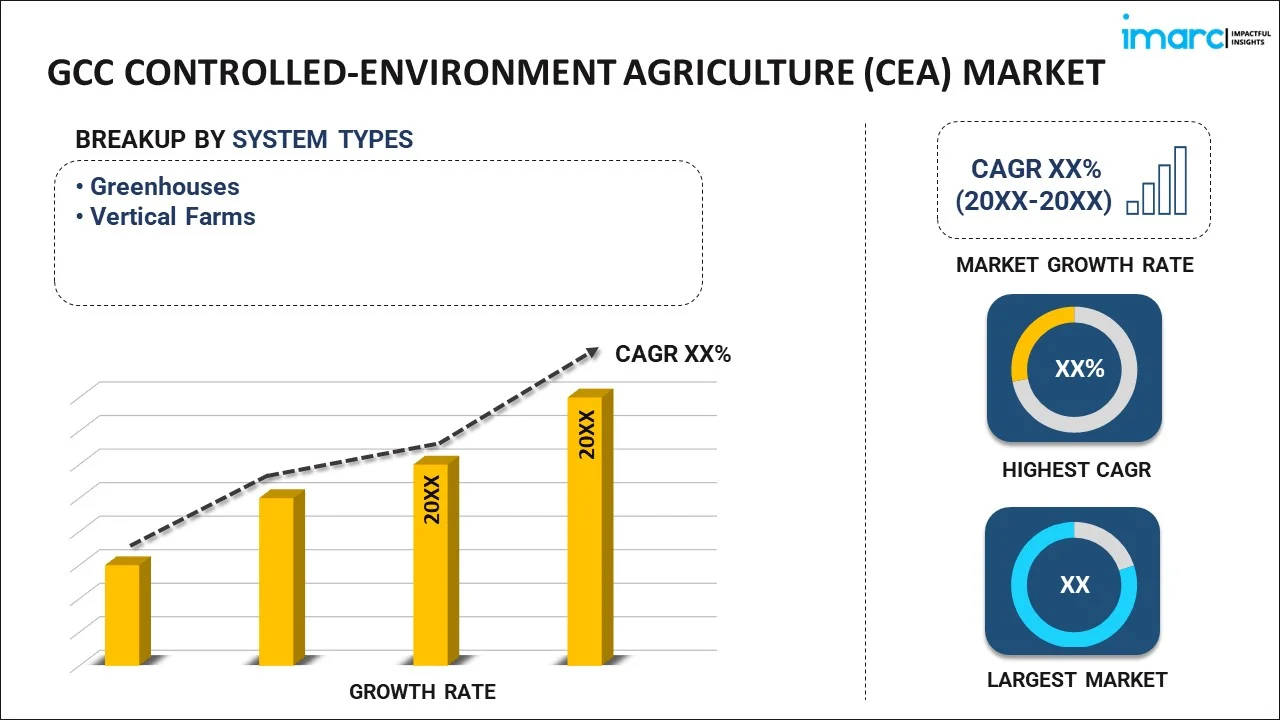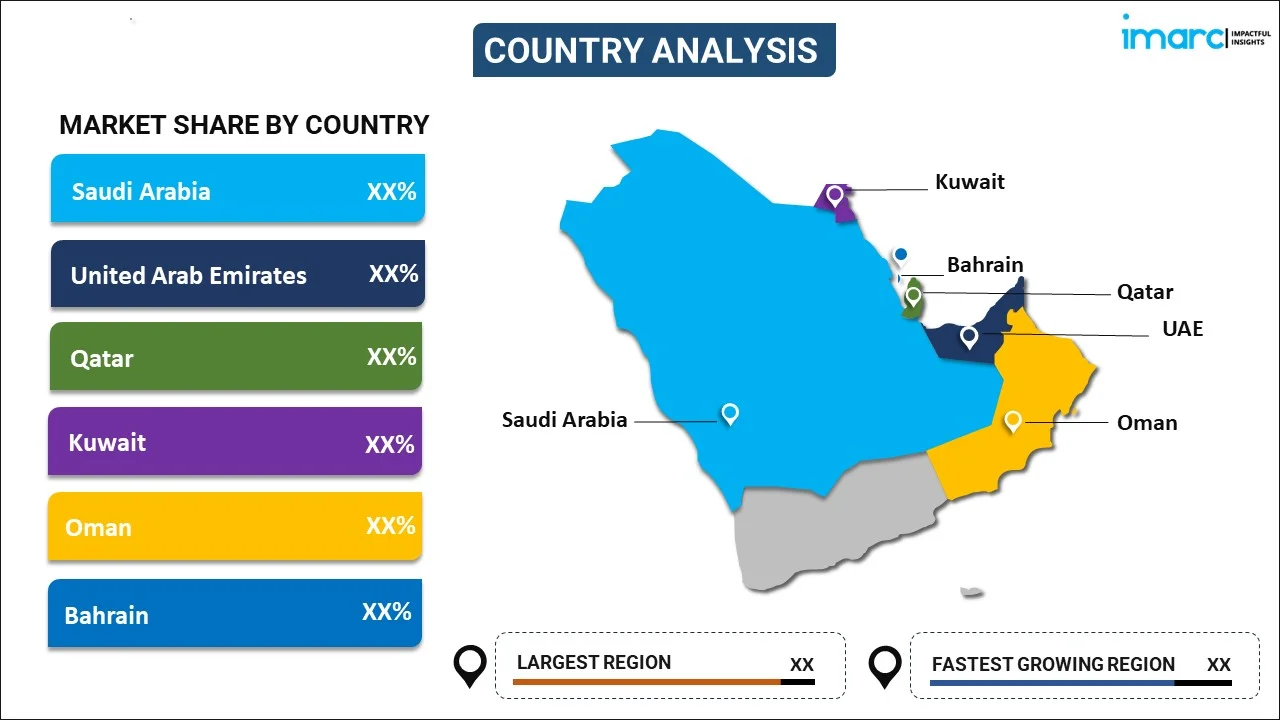
GCC Controlled-Environment Agriculture (CEA) Market Report by System Type (Greenhouses, Vertical Farms), Growing Method (Hydroponics, Aeroponics, Aquaponics), Crop Type (Cereals, Fruits, Vegetable, and Others), and Country 2025-2033
Market Overview:
The GCC controlled-environment agriculture (CEA) market size reached USD 490.6 Million in 2024. Looking forward, IMARC Group expects the market to reach USD 2,831 Million by 2033, exhibiting a growth rate (CAGR) of 21.5% during 2025-2033. The widespread adoption of CEA, as it enables more efficient utilization of water, the GCC governments' strategic vision to diversify the economy, and the growing awareness of sustainable farming practices are some of the key factors driving the market.
|
Report Attribute
|
Key Statistics
|
|---|---|
|
Base Year
|
2024 |
|
Forecast Years
|
2025-2033
|
|
Historical Years
|
2019-2024
|
| Market Size in 2024 | USD 490.6 Million |
| Market Forecast in 2033 | USD 2,831 Million |
| Market Growth Rate (2025-2033) | 21.5% |
Controlled-environment agriculture (CEA) is a technology-driven approach to indoor farming that gives complete control over the environment in which plants are grown. By carefully monitoring and managing factors like light, temperature, humidity, and carbon dioxide levels, CEA enables crop cultivation in conditions optimized for growth. This method eliminates the need for pesticides and reduces water usage by up to 90% compared to traditional farming, resulting in a more sustainable agricultural practice. Furthermore, CEA allows for year-round production, regardless of external weather conditions, ensuring a consistent and reliable crop yield. The use of advanced technologies in CEA also leads to higher crop quality and nutritional content. It is an essential tool in addressing the growing demand for food in urban areas and places with limited arable land. By offering precise control over growing conditions, CEA represents a significant advancement in agriculture, aligning with modern needs for efficiency, sustainability, and quality in food production.
GCC Controlled-Environment Agriculture (CEA) Market Trends:
Controlled-environment agriculture (CEA) in the Gulf Cooperation Council (GCC) region is experiencing significant growth, driven by the scarcity of water resources in the area. This is promoting the adoption of CEA, as it enables more efficient utilization of water, consuming less than traditional farming methods. Along with this, the region's harsh climatic conditions, marked by high temperatures and arid land, have also led to an increased interest in CEA, which allows for the creation of optimal growing conditions inside a controlled environment, thereby influencing the market growth. In confluence with this, the GCC governments' strategic vision to diversify the economy and reduce dependence on oil revenues is contributing to investments and favorable policies in the agriculture sector, particularly in CEA, which is acting as a growth-inducing factor. Apart from this, the accelerating emphasis on food security, the need to reduce the reliance on imported food products, and the growing consumer preference for fresh and locally-produced items are also driving the market positively across the region. Additionally, continual technological innovations, such as the emergence of advanced climate control systems and automation, further enhance CEA's productivity and appeal in the GCC, thereby creating a positive market outlook. Furthermore, the rise in urbanization and growing awareness of sustainable farming practices are fostering the growth of vertical and urban farming within controlled environments. Some of the other factors driving the market include increasing awareness among the masses, rising investments by governing bodies and key players, and changing consumer preferences across the region.
GCC Controlled-Environment Agriculture (CEA) Market Segmentation:
IMARC Group provides an analysis of the key trends in each segment of the GCC controlled-environment agriculture (CEA) market report, along with forecasts at the regional and country levels for 2025-2033. Our report has categorized the market based on system type, growing method, and crop type.
System Type Insights:

- Greenhouses
- Vertical Farms
The report has provided a detailed breakup and analysis of the market based on the system type. This includes greenhouses and vertical farms.
Growing Method Insights:
- Hydroponics
- Aeroponics
- Aquaponics
A detailed breakup and analysis of the market based on the growing method has also been provided in the report. This includes hydroponics, aeroponics, and aquaponics.
Crop Type Insights:
- Cereals
- Fruits
- Vegetable
- Others
The report has provided a detailed breakup and analysis of the market based on the crop type. This includes cereals, fruits, vegetable, and others.
Country Insights:

- Saudi Arabia
- United Arab Emirates
- Bahrain
- Kuwait
- Oman
- Qatar
The report has also provided a comprehensive analysis of all the major regional markets, which include Saudi Arabia, United Arab Emirates, Bahrain, Kuwait, Oman, and Qatar.
Competitive Landscape:
The report has also provided a comprehensive analysis of the competitive landscape in the market. Competitive analysis such as market structure, key player positioning, top winning strategies, competitive dashboard, and company evaluation quadrant has been covered in the report. Also, detailed profiles of all major companies have been provided.
GCC Controlled-Environment Agriculture (CEA) Market Report Scope:
| Report Features | Details |
|---|---|
| Base Year of the Analysis | 2024 |
| Historical Period | 2019-2024 |
| Forecast Period | 2025-2033 |
| Units | Million USD |
| Scope of the Report | Exploration of Historical and Forecast Trends, Industry Catalysts and Challenges, Segment-Wise Historical and Predictive Market Assessment:
|
| System Types Covered | Greenhouses, Vertical Farms |
| Growing Methods Covered | Hydroponics, Aeroponics, Aquaponics |
| Crop Types Covered | Cereals, Fruits, Vegetable, Others |
| Countries Covered | Saudi Arabia, UAE, Qatar, Bahrain, Kuwait, Oman |
| Customization Scope | 10% Free Customization |
| Post-Sale Analyst Support | 10-12 Weeks |
| Delivery Format | PDF and Excel through Email (We can also provide the editable version of the report in PPT/Word format on special request) |
Key Questions Answered in This Report:
- How has the GCC controlled-environment agriculture (CEA) market performed so far and how will it perform in the coming years?
- What has been the impact of COVID-19 on the GCC controlled-environment agriculture (CEA) market?
- What is the breakup of the GCC controlled-environment agriculture (CEA) market on the basis of system type?
- What is the breakup of the GCC controlled-environment agriculture (CEA) market on the basis of growing method?
- What is the breakup of the GCC controlled-environment agriculture (CEA) market on the basis of crop type?
- What are the various stages in the value chain of the GCC controlled-environment agriculture (CEA) market?
- What are the key driving factors and challenges in the GCC controlled-environment agriculture (CEA) market?
- What is the structure of the GCC controlled-environment agriculture (CEA) market and who are the key players?
- What is the degree of competition in the GCC controlled-environment agriculture (CEA) market?
Key Benefits for Stakeholders:
- IMARC’s report offers a comprehensive quantitative analysis of various market segments, historical and current market trends, market forecasts, and dynamics of the GCC controlled-environment agriculture (CEA) market from 2019-2033.
- The research study provides the latest information on the market drivers, challenges, and opportunities in the GCC controlled-environment agriculture (CEA) market.
- Porter's five forces analysis assist stakeholders in assessing the impact of new entrants, competitive rivalry, supplier power, buyer power, and the threat of substitution. It helps stakeholders to analyze the level of competition within the GCC controlled-environment agriculture (CEA) industry and its attractiveness.
- Competitive landscape allows stakeholders to understand their competitive environment and provides an insight into the current positions of key players in the market.
Need more help?
- Speak to our experienced analysts for insights on the current market scenarios.
- Include additional segments and countries to customize the report as per your requirement.
- Gain an unparalleled competitive advantage in your domain by understanding how to utilize the report and positively impacting your operations and revenue.
- For further assistance, please connect with our analysts.
 Inquire Before Buying
Inquire Before Buying
 Speak to an Analyst
Speak to an Analyst
 Request Brochure
Request Brochure
 Request Customization
Request Customization




.webp)




.webp)












